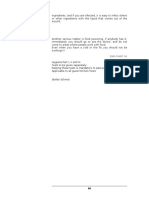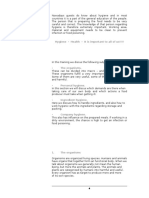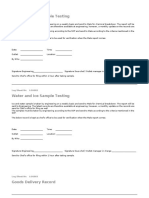0 ratings0% found this document useful (0 votes)
14 viewsMacronn
Macronn
Uploaded by
mohamed.mauroofThe document discusses different categories of organisms including macro organisms like rodents, insects, and parasites and micro organisms like bacteria, fungi, yeasts, and viruses. It further categorizes micro organisms based on their functions as useful, harmful, or disease-causing. Useful micro organisms help break down dead plants and animals or are involved in food production like vinegar, yogurt, and cheese. Harmful micro organisms can damage, sicken, or kill organisms while disease-causing pathogens specifically cause illnesses. Proper actions must be taken to prevent harmful microbes.
Copyright:
© All Rights Reserved
Available Formats
Download as PDF, TXT or read online from Scribd
Macronn
Macronn
Uploaded by
mohamed.mauroof0 ratings0% found this document useful (0 votes)
14 views1 pageThe document discusses different categories of organisms including macro organisms like rodents, insects, and parasites and micro organisms like bacteria, fungi, yeasts, and viruses. It further categorizes micro organisms based on their functions as useful, harmful, or disease-causing. Useful micro organisms help break down dead plants and animals or are involved in food production like vinegar, yogurt, and cheese. Harmful micro organisms can damage, sicken, or kill organisms while disease-causing pathogens specifically cause illnesses. Proper actions must be taken to prevent harmful microbes.
Original Title
macronn
Copyright
© © All Rights Reserved
Available Formats
PDF, TXT or read online from Scribd
Share this document
Did you find this document useful?
Is this content inappropriate?
The document discusses different categories of organisms including macro organisms like rodents, insects, and parasites and micro organisms like bacteria, fungi, yeasts, and viruses. It further categorizes micro organisms based on their functions as useful, harmful, or disease-causing. Useful micro organisms help break down dead plants and animals or are involved in food production like vinegar, yogurt, and cheese. Harmful micro organisms can damage, sicken, or kill organisms while disease-causing pathogens specifically cause illnesses. Proper actions must be taken to prevent harmful microbes.
Copyright:
© All Rights Reserved
Available Formats
Download as PDF, TXT or read online from Scribd
Download as pdf or txt
0 ratings0% found this document useful (0 votes)
14 views1 pageMacronn
Macronn
Uploaded by
mohamed.mauroofThe document discusses different categories of organisms including macro organisms like rodents, insects, and parasites and micro organisms like bacteria, fungi, yeasts, and viruses. It further categorizes micro organisms based on their functions as useful, harmful, or disease-causing. Useful micro organisms help break down dead plants and animals or are involved in food production like vinegar, yogurt, and cheese. Harmful micro organisms can damage, sicken, or kill organisms while disease-causing pathogens specifically cause illnesses. Proper actions must be taken to prevent harmful microbes.
Copyright:
© All Rights Reserved
Available Formats
Download as PDF, TXT or read online from Scribd
Download as pdf or txt
You are on page 1of 1
1.1 Categories of organisms.
- Macro organisms
- Micro organisms
Macro organisms can be big, and are very clearly visible with
our eyes. However that does not mean that we always see
them. They can be hidden somewhere.
The different types of macro organisms are:
- Rodents (rats and mice)
- Insects
- Parasites.
Sometimes parasites are also categorized under micro
organisms. Example a bacteria who stay alive while causing
others damage, illness or death.
The different types of micro organisms are:
- Bacteria
- Fungi, yeast and mold
- Virus
1.2 Categories of organisms by function.
There are different classifications of micro organisms. It all
depends on their function.
They are classified as below:
a- Useful micro organisms
b- Harmful micro organisms
c- Decease causing micro organisms (also called
pathogens)
Without micro organisms we cannot live, but some micro
organisms can cause us severe damage, illness and even in
the worst case death. We have to take therefore several
actions to prevent bad micro organisms from existing.
a. Useful micro organisms
Most micro organisms have a useful function. In nature they
help to “eat” dead plants or animals and they clean water.
Concerning to food, bacteria fulfill a very important role in
the preparation of example: vinegar, yogurt and sauerkraut.
Some fungi are important with the preparation of cheese,
example: blue cheese and camembert. Certain types of
yeast are important for the preparation of wine, beer and
bread.
b. Harmful micro organisms
You might also like
- Microbes in Daily LifeDocument36 pagesMicrobes in Daily LifeSusheel Gupta71% (7)
- Basic Lesson Plan Class 8 Microorganism Friend and FoeDocument53 pagesBasic Lesson Plan Class 8 Microorganism Friend and FoeRasika PK Gore88% (24)
- Useful Microbes - Microbes in Human WelfareDocument8 pagesUseful Microbes - Microbes in Human WelfareSanjaya SahooNo ratings yet
- Microorganisms in Our Everyday LifeDocument13 pagesMicroorganisms in Our Everyday Lifechristian100% (5)
- Form 5 Science: Microorganisms and Their Effects On Living ThingsDocument54 pagesForm 5 Science: Microorganisms and Their Effects On Living Thingsnicky1213aNo ratings yet
- SCIENCE Presentation MicroorganismsDocument11 pagesSCIENCE Presentation MicroorganismsBalan MuthuNo ratings yet
- Micro OrganismsDocument6 pagesMicro Organismsjanathiefernando23No ratings yet
- MicroorganismsDocument2 pagesMicroorganismsVan ChimexNo ratings yet
- Microorganisms Mind MapDocument6 pagesMicroorganisms Mind Mapfebinstr339No ratings yet
- Microorganism Facts For KidsDocument18 pagesMicroorganism Facts For KidsMocomi KidsNo ratings yet
- The Harm and The Benefits of Micro-OrganismsDocument4 pagesThe Harm and The Benefits of Micro-OrganismsMihoc BiankNo ratings yet
- Microorganisms Friend and Foe Class 8thDocument7 pagesMicroorganisms Friend and Foe Class 8thojasvmiglaniNo ratings yet
- Cabornay MC3 1stDocument22 pagesCabornay MC3 1stDaisy RoseteNo ratings yet
- Microbiology Awareness ProgramDocument28 pagesMicrobiology Awareness ProgramMo'men Abu El ElaaNo ratings yet
- 8 Science Microorganisms PDFDocument6 pages8 Science Microorganisms PDFPrashant SinghNo ratings yet
- Grade 8 CBSE (Biology) : Paste This Paper in Your Biology Note Book and Learn Them Thoroughly. Test On 20 Octt)Document2 pagesGrade 8 CBSE (Biology) : Paste This Paper in Your Biology Note Book and Learn Them Thoroughly. Test On 20 Octt)Khaled Turk0% (1)
- C. Decease Causing Micro OrganismsDocument1 pageC. Decease Causing Micro Organismsmohamed.mauroofNo ratings yet
- Chapter 1 MicroparaDocument78 pagesChapter 1 MicroparaGodwin Miles Angelo AdtoonNo ratings yet
- Bio Review Notes Microorganisms Class 8Document5 pagesBio Review Notes Microorganisms Class 8Abeer VermaNo ratings yet
- BacteriaDocument8 pagesBacteriamaxribeiro@yahoo.comNo ratings yet
- CH 2 Microorganism Friend and FoeDocument23 pagesCH 2 Microorganism Friend and FoeVidya MahajanNo ratings yet
- DocumentDocument2 pagesDocumentZeenoor sajidNo ratings yet
- Micro OrganismsDocument7 pagesMicro Organismssharanyaa54No ratings yet
- Exp SC 8 - Chapter 02Document18 pagesExp SC 8 - Chapter 02megamind publicationNo ratings yet
- Lecture 14-Microbes - BacteriaDocument13 pagesLecture 14-Microbes - BacteriaLègóka Teija UrsulaNo ratings yet
- 8th Full Science-2Document201 pages8th Full Science-2great kashmirNo ratings yet
- Cbse Class 8 Science Notes Chapter 2Document9 pagesCbse Class 8 Science Notes Chapter 2Sashwat KanungoNo ratings yet
- MicroorganismsDocument3 pagesMicroorganismsbossmanp776No ratings yet
- Stew BorwnDocument1 pageStew Borwnmohamed.mauroofNo ratings yet
- Microbes in My Life HandoutDocument3 pagesMicrobes in My Life Handoutsardarswapan219No ratings yet
- Microorganism Frends and Foe NotesDocument5 pagesMicroorganism Frends and Foe Notesmatho logyNo ratings yet
- Microorganisms Friend and Foe Class 8 Notes Science Chapter 2Document4 pagesMicroorganisms Friend and Foe Class 8 Notes Science Chapter 2abigail.anil2010No ratings yet
- Microbiology Introduction BurtonDocument14 pagesMicrobiology Introduction BurtonmagallonesjohndieNo ratings yet
- Class8 Biology Chapter 2.Micro-Organisms Friend & FoeDocument35 pagesClass8 Biology Chapter 2.Micro-Organisms Friend & Foeansariafeefa.1230100% (1)
- Micro OrganismDocument6 pagesMicro OrganismmaanyaNo ratings yet
- Chapter 2 MicroorganismsDocument9 pagesChapter 2 MicroorganismsNIKHILPATNINo ratings yet
- 2024 Chapter 2 NotesDocument3 pages2024 Chapter 2 NotesXAVIER'S CMI PUBLIC SCHOOLNo ratings yet
- En Probiotic and Synbiotic Cleaning 2020Document14 pagesEn Probiotic and Synbiotic Cleaning 2020kamil.oberbek.consultingNo ratings yet
- Microorganisms ReadingDocument3 pagesMicroorganisms Readingapi-548153301No ratings yet
- Microbes NotesDocument22 pagesMicrobes Notesapi-218511741100% (1)
- UNIT-2 Microorganisms in Food: Alcaligens Leads To Ropiness in Milk and YoghurtDocument8 pagesUNIT-2 Microorganisms in Food: Alcaligens Leads To Ropiness in Milk and YoghurtAryan BharadwaajNo ratings yet
- THC-122-Notes For Midterm (Charrr)Document4 pagesTHC-122-Notes For Midterm (Charrr)Ristie LimbagNo ratings yet
- Made by - Vithika SinghDocument8 pagesMade by - Vithika Singhvs ChoudharyNo ratings yet
- Document 6Document25 pagesDocument 6lanjwanimehranaliNo ratings yet
- SVS Revision Booklet 2024 (Answers)Document10 pagesSVS Revision Booklet 2024 (Answers)sqsq2bbgmfNo ratings yet
- ScienceDocument5 pagesScienceunknownNo ratings yet
- MicroorganismsDocument17 pagesMicroorganismsLindzhy LimNo ratings yet
- Microbiology of Food... NotesDocument18 pagesMicrobiology of Food... NotesRyan KarlNo ratings yet
- Class 8 Science Notes Chapter 2 MicroorganismsDocument4 pagesClass 8 Science Notes Chapter 2 MicroorganismsPrathamesh . M LaddhadNo ratings yet
- Lecture 02 MicrobiologyDocument4 pagesLecture 02 Microbiologymohamedlaissani209No ratings yet
- Topic 03 Microbes in Our LifeDocument2 pagesTopic 03 Microbes in Our LifeMuhammad Yaseen shahNo ratings yet
- Good and Bad Microbes-2Document4 pagesGood and Bad Microbes-2Hot Chocolate & SmoresNo ratings yet
- Micro Organisms 1Document5 pagesMicro Organisms 1kpsivamsportsNo ratings yet
- Unit 3 Monera KingdomDocument6 pagesUnit 3 Monera KingdomYolanda Fernández VelascoNo ratings yet
- Micro-Organisms Class 8thDocument24 pagesMicro-Organisms Class 8thBhavani RajuNo ratings yet
- Exploring The World of MicroorganismsDocument2 pagesExploring The World of Microorganismsakhsariaz786No ratings yet
- Germs, Fungus and Other Stuff That Makes Us Sick | A Children's Disease Book (Learning about Diseases)From EverandGerms, Fungus and Other Stuff That Makes Us Sick | A Children's Disease Book (Learning about Diseases)No ratings yet
- Fire HeartDocument1 pageFire Heartmohamed.mauroofNo ratings yet
- Rachael Miller Ashley Colpaart Meghan King Dawn Meader MccauslandDocument1 pageRachael Miller Ashley Colpaart Meghan King Dawn Meader Mccauslandmohamed.mauroofNo ratings yet
- Soaking Time PDFDocument1 pageSoaking Time PDFmohamed.mauroofNo ratings yet
- Polop PDFDocument1 pagePolop PDFmohamed.mauroofNo ratings yet
- The Sensitive Skin of The HandsDocument1 pageThe Sensitive Skin of The Handsmohamed.mauroofNo ratings yet
- Quest Mike PDFDocument1 pageQuest Mike PDFmohamed.mauroofNo ratings yet
- 4.1 Maintenance of The Body The SkinDocument1 page4.1 Maintenance of The Body The Skinmohamed.mauroofNo ratings yet
- Oike MasterDocument1 pageOike Mastermohamed.mauroofNo ratings yet
- Hay TimeDocument1 pageHay Timemohamed.mauroofNo ratings yet
- Bacteria That Causes Food SpoilageDocument1 pageBacteria That Causes Food Spoilagemohamed.mauroofNo ratings yet
- Trust OnnoDocument1 pageTrust Onnomohamed.mauroofNo ratings yet
- Table TopsDocument1 pageTable Topsmohamed.mauroofNo ratings yet
- Stew BorwnDocument1 pageStew Borwnmohamed.mauroofNo ratings yet
- Temporry PottuDocument1 pageTemporry Pottumohamed.mauroofNo ratings yet
- Dig DeeperDocument1 pageDig Deepermohamed.mauroofNo ratings yet
- Blank FigDocument1 pageBlank Figmohamed.mauroofNo ratings yet
- Humidity / Water: Temperature Scale For BacteriaDocument1 pageHumidity / Water: Temperature Scale For Bacteriamohamed.mauroofNo ratings yet
- PH Scale, From 0 To 14: OxygenDocument1 pagePH Scale, From 0 To 14: Oxygenmohamed.mauroofNo ratings yet
- Wire SeamDocument1 pageWire Seammohamed.mauroofNo ratings yet
- 2.2 Insects and Spiders (And Spider Family)Document1 page2.2 Insects and Spiders (And Spider Family)mohamed.mauroofNo ratings yet
- At The Receiving AreaDocument1 pageAt The Receiving Areamohamed.mauroofNo ratings yet
- Done TrackDocument1 pageDone Trackmohamed.mauroofNo ratings yet
- Prevention of Macro OrganismsDocument1 pagePrevention of Macro Organismsmohamed.mauroofNo ratings yet
- Refrigerators, PDFDocument1 pageRefrigerators, PDFmohamed.mauroofNo ratings yet
- C. Decease Causing Micro OrganismsDocument1 pageC. Decease Causing Micro Organismsmohamed.mauroofNo ratings yet
- Intro: "Health Is The Condition of Completely Physical, Mental and Social Well Being Without Illness or Weakness"Document1 pageIntro: "Health Is The Condition of Completely Physical, Mental and Social Well Being Without Illness or Weakness"mohamed.mauroofNo ratings yet
- Hygiene - Health - It Is Important To All of Us!!!!Document1 pageHygiene - Health - It Is Important To All of Us!!!!mohamed.mauroofNo ratings yet
- Product Temperatu Re Condition Comments: Log Sheet NR: LOG004Document1 pageProduct Temperatu Re Condition Comments: Log Sheet NR: LOG004mohamed.mauroofNo ratings yet
- From The Receiver, The Assigned PDFDocument1 pageFrom The Receiver, The Assigned PDFmohamed.mauroofNo ratings yet
- Water and Ice Sample Testing: Log Sheet NR: LOG002Document1 pageWater and Ice Sample Testing: Log Sheet NR: LOG002mohamed.mauroofNo ratings yet























































































